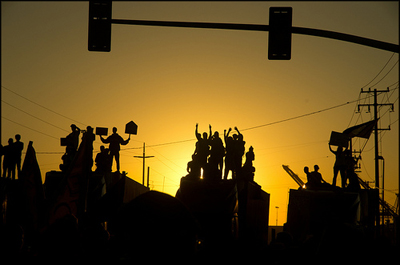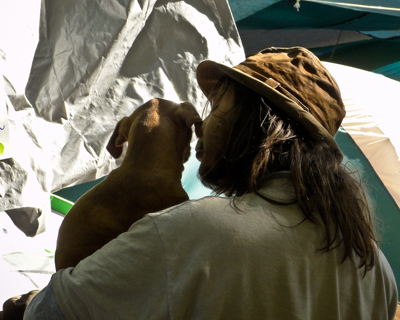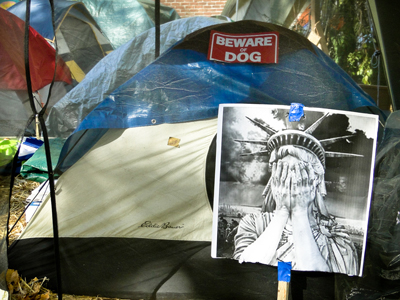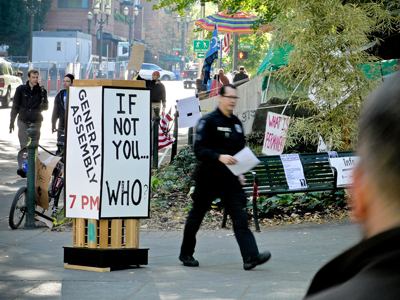Occupy Everywhere: The West Coast
My tour has kept me from spending as much time at the Occupations as I would have liked, so some of these observations were made in brief visits. Writing this piece took me a long time because, as a fan girl of the revolution, I was uncomfortable with my negative feelings towards the occupations – especially in light of such horrendous police brutality in Oakland, CA. But I also believe that opposing opinions, dissent and criticism are very necessary for the movement, and that supporters should not be afraid to voice their concerns and observations.

Photo by Margaret Killjoy.
Oakland
My own visit to Occupy Oakland was brief and pre-dated all the police violence, but it had a lot going for it, a racially diverse crowd, the OWS standards of kitchen, library, and medical tent, its own police, and a feeling of community. Oakland is a city that needs all the forward, peaceful momentum it can get. Oakland is also a very progressive Occupation, pushing for radical actions such as the general strike on November 2nd, and for the peaceful occupation of foreclosed and abandoned properties in Oakland. Those are both brave initiatives. The occupation of foreclosed properties being especially dangerous, not only because of the police force but because Oakland can be a very dangerous city regardless of the police.
After I left the city Occupy Oakland took center stage in the movement. This is an important strength, showing that the leaderless movement is committed to supporting the actions of protesters all over the country (and the world.) The focus started on Wall Street but the problem is everywhere and a shifting center gives more people a voice.
For more #OO coverage read Myles Boisen, whose been on the ground there since the first night of police violence, through to the General Strike on Nov. 2nd.

Photo by Elijah Nouvelage.
Occupy San Francisco
The first time I went to Occupy San Francisco, what I found was a ragged band of protesters occupying a narrow strip of sidewalk outside the Federal Reserve of San Francisco. And they looked crazy. Shirtless, yelling, brandishing signs. San Francisco has been plagued by a the SFPD from early on in their Occupation, so the infrastructure was hobbled when I initially visited.
My second visit included a large march (15K) from City Hall to the encampment. The crowd was diverse in age and apparent income level and had a great energy:

Photo by Audrey Penven.
I got to see the bike generator and a little bit of the infrastructure. The large hacker contingent in SF is also cause for hope, as OWS is a perfect testing ground for new technologies and an inspiration for a generation of highly intelligent, curious, and motivated people who are not being used to their full advantage by a society that only requires them to make coffee, wait tables, or program better shopping carts for online merchants.
Portland (All PDX photos by Merrick Monroe. Additionally, more “action shot”-centric images by Merrick are viewable here.)
Occupy Portland is big– two city blocks of tents set in some lushly treed parks in downtown Portland, Oregon. The infrastructure is impressive, with shelters and tents grouped together making little neighborhoods in the camp. Their kitchen is large and well stocked. Their library is housed under a giant blue tarp. The promenades and benches in the park make the occupation more inviting to walk through than other tented occupations I have seen.

There is a cafe, and a stage with a sound system where people can sign up to play music. People wander through the camp, lounge on benches, talk, smoke, and play with an abundance of puppies and kittens.

As I wandered through, looking at signs, observing and asking questions I was inspired and interested. But as I explored more, I felt that the organizers of Occupy Portland had looked at Occupy Wall Street, had copied their infrastructure, had ticked off all the right boxes, and had now settled in for a long camp out with their friends.
What I found in Portland is exactly what people – many of them supporters of OWS – are complaining about: that the aesthetic of the camps are a turn off, that the occupiers look like hippies, slackers, losers, and freeloaders.

I believe it doesn’t matter what Occupiers look like. Some people think that wearing a suit is a good tactic, but I think reinforcing the old aesthetic stereotypes marginalizes the voices of some very important, intelligent, and forward thinking people; people who opted out of a broken system before others did. We should not ignore the early adopters of a better future.

But maybe Occupy Portland is a little too comfortable, a little too complacent. With no real Wall Street, a supportive mayor, and well, the whole West Coast on its side, there may actually be nothing revolutionary about it.
It will be important as the movement progresses to allow each Occupation to evolve in it’s own way. Maybe each and every city doesn’t need a permanent encampment. Or maybe the cities where camping is being permitted are the places where the Occupiers have room to push the movement even further, instead of having camp outs they can occupy foreclosed homes… or more? As each city has it’s own local strengths and issues it will be important for each local chapter of OWS to be in touch with it’s local population, rather than just Occupying because that’s what the people in New York are doing.

Further Reading:
- “One of the great dangers the protesters face is that they will fall in love with themselves.” – Slajov Žižek
- “The more familiar something looks, the less threatening it seems.” – Douglas Rushkoff
- The Declaration of Interdependence
- “Never in my life did I imagine I’d be sitting with a group of adults seriously debating policy as if our decision made a difference.” – Lili Loofbourow :
- “…Zuccotti Park … this once architecturally banal plaza, framed by silently thundering corporate tombstones, is becoming both the graveyard of a deceased economic dogma and the cradle of the revolution.” – Russell Brand
